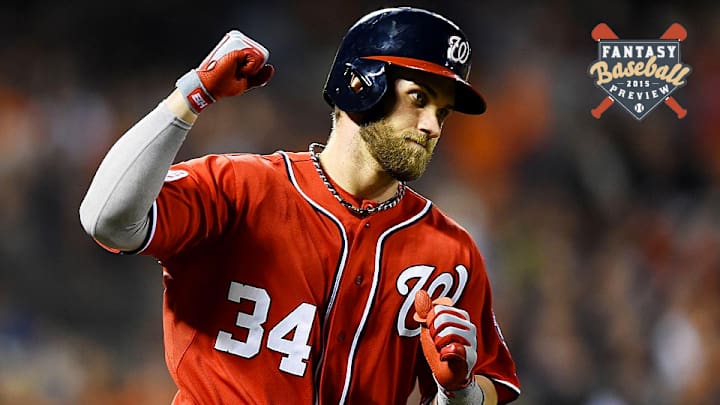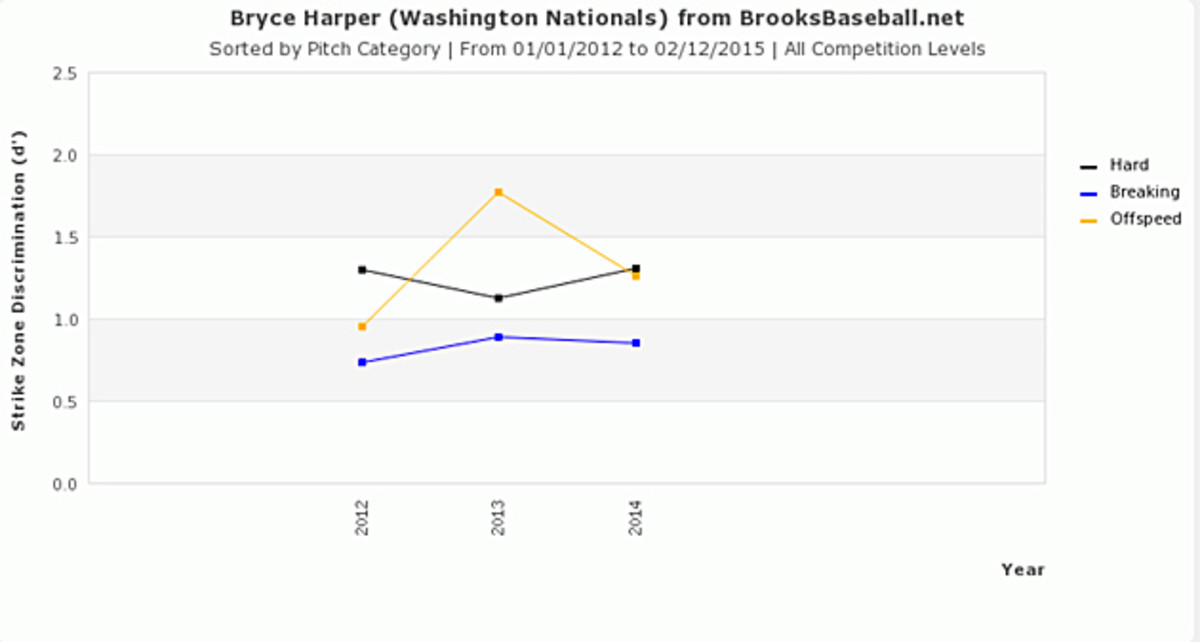Is this the year Bryce Harper stakes his claim as perennial superstar?

With fantasy baseball drafts on the horizon, Michael Beller will answer a series of burning questions leading up to the start of the MLB season.
What do Kris Bryant, Taijuan Walker, Joc Pederson, Noah Syndergaard, Jorge Soler, Archie Bradley, Jon Gray, Blake Swihart and Henry Owens have in common? They’re all top-20 prospects, according to MLB.com. They’re also all older than Bryce Harper.
• Fantasy baseball 2015 draft kit: Everything you need to prep for your draft
That’s the first thing to keep in mind any time you hear someone wondering what happened to Harper last year. It may have been his third season in the majors, but we’re talking about a guy who turned 22 during the playoffs. Harper may have had a disappointing 2014 season, but the question here isn’t "does he bounce back?" Instead, it’s "how far back does Harper come, and is this the year he takes off as a perennial superstar?"
Fantasy Baseball Top 250 Rankings
If Harper is going to be the guy everyone wants him to be, he’s going to have to tailor his playing style, at least a little, to stay healthy. Harper has lost huge chunks of two of his three seasons due to injury. Last year, he played in just 100 games after tearing a ligament in his thumb on a head-first slide. The year before, he missed 44 games, some of which came after he smashed into the wall in center field. Harper’s reckless abandon makes him an exciting player, and his aggressiveness certainly can contribute positively to what he does on the field, but the Nationals and his fantasy owners alike wouldn’t mind seeing him dial it back at times if it meant him playing 150-plus games.
Before we get to the good with Harper, and believe me, there’s a lot of it, let’s acknowledge a few steps back he took on the field last year. His strikeout rate skyrocketed to 26.3 percent and his swinging-strike rate climbed to a career-worst 13.7 percent. Interestingly, Harper did not lose his discipline at the plate. Brooks Baseball tracks a stat they call strike zone discrimination, which measures how strong a handle a hitter has on the zone. The scale goes from 0-to-2, with zero representing Sammy Sosa and two representing Tony Gwynn. Here’s Harper’s chart from year to year.

There has been some fluctuation in his discipline when seeing off-speed pitches, but he was still better last year than he was in 2012. As for hard and breaking pitches, his performance has remained essentially flat, with his discipline against fastballs actually improving a bit last year from 2013.
Harper’s problem last year wasn’t swinging at bad pitches, but making contact on good ones. His z-contact rate, which measures the percentage of times a hitter makes contact when swinging at pitches in the strike zone, was just 82.9 percent last year. League average fluctuates from year to year, but it’s typically around 87 percent. Harper’s rate last year had him tied with Dexter Fowler for 136th in the league.
• FANTASY: BREAKOUTS | SLEEPERS | BUSTS
The good news is that when Harper did make contact in the zone, he had the best results of his young career. Harper hit .395 and slugged .673 in his at-bats that ended with a pitch in the strike zone. In 2013, those numbers were at .343 and .634, while in 2012 he hit .321 and slugged .667 on pitches in the zone. When Harper made contact, all was right in the world. The problem was he didn’t do so enough.
Going beyond Harper’s contact stats, we find plenty of reason to believe that 2015 will be his best season yet. He undoubtedly benefited from a .352 BABIP, but it actually wasn’t that much higher than his .335 xBABIP. Harper hit a ton of line drives (21.8 percent line-drive rate) and, as we showed above, when he made contact it was hard to argue with the outcome. His HR/FB ratio fell to a career low 15.5 percent, but that’s not yet a cause for concern. First of all, it remained comfortably better than league average. Secondly, we can chalk up at least some of his sapped power to the thumb injury.
Power Rankings: Nationals take top spot ahead of spring training
Even though it was on his left hand, the top hand for a left-handed hitter, any injury in that area of the body is going to cause some problems when a player first returns. Harper had just one home run before the injury. He had 12 after it, but his average true home run distance, as measured by ESPN’s hit tracker, was just 397.8 feet. It was 413 feet his rookie year and 405.5 feet in 2013. Guys just don’t lose their power at 21 years old. The thumb injury is to blame here.
Harper’s career fly-ball rate is 33.5 percent, and he has been within one percentage point of that mark in all three seasons of his career. We can pretty safely say that about one-third of his batted balls will take flight. Even if his HR/FB ratio stays down in the 15- to 16-percent range, and even if he misses, say, 20 games, if he can cut back to his Steamer-projected 20.3 percent strikeout rate, he’ll hit somewhere in the neighborhood of 22 to 23 home runs. Of course, that would also assume that he’s done growing as a hitter and has maxed out his pop. Rarely is that the case for a 22-year-old. A fully healthy Harper playing a full season of baseball should provide a minimum of 25 homers.
• POSITION PREVIEWS: SP | RP | 1B | 2B | SS | 3B | OF | C
From a purely fantasy standpoint, consider also the lineup of which he is a part. Harper should hit in the middle of the order, most likely fourth behind Denard Span, Anthony Rendon and Jayson Werth. Span has a career OBP of .352. Rendon is a rising star who hit .287/.351/.473 last year. Werth’s career OBP is .370 and he has been at .387 or better every year since 2012. In other words, Harper is going to have plenty of RBI opportunities this season.
Harper is always going to deal with more than his fair share of criticism. Part of it is his brash attitude, part of it is the expectations he has had his whole career and part of it is the fact that he will always be compared to Mike Trout. Don’t let the misguided belief that he hasn’t measured up to this point of his career cloud your judgment at the draft table. Harper is a top-30 asset, regardless of your fantasy baseball format.
• BURNING QUESTION I: Is Miguel Cabrera still a first-round pick?
• BURNING QUESTION II: Will Kemp and Braun live up to their price?
• BURNING QUESTION III: Will Harper reach superstar status this year?
• BURNING QUESTION IV: Worth it to draft the oft-injured Tulowitzki?
• BURNING QUESTION V: Coming off surgery, how big a risk is Harvey?
• BURNING QUESTION VI: Invest in Adam Jones's boring consistency?
• BURNING QUESTION VII: Could Strasburg emerge as No. 1 fantasy SP?
• BURNING QUESTION VIII: Will Alcantara emerge as a top-10 2B?
